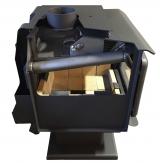Frequent Questions about Wood-Burning Appliances
Below are answers to questions EPA has received about wood-burning appliances and wood smoke.
On this page:
Selection of Stoves and Accessories
- What technologies do certified stoves use to improve efficiency and reduce emissions?
- What is the difference between catalytic and non-catalytic wood stoves?
- Are gas stoves cleaner than wood stoves or pellet stoves?
- What is a pellet stove? Do they burn cleaner?
- Is there such a thing as a corn stove? Do they burn cleaner than wood stoves?
- What about gas or propane stoves? Are they EPA-certified?
- What is a forced-air furnace?
- What is a hydronic heater/outdoor wood boiler?
- What is the best stove for me – type, size, cost?
- How do fireplaces compare to wood stoves? Are they as efficient?
- What is the difference between a masonry heater and a masonry fireplace?
- What are fireplace inserts?
- What are firelogs?
- Are manufactured fire logs okay to burn in fireplaces? Do they emit more or less air pollution than wood?
- What are ethanol fireplaces and how are they different from wood burning fireplaces?
- How are EPA-certified stoves different, and why are they better?
- Where can I purchase an EPA-certified stove?
- Is "EPA-certified" the same as "EPA-qualified"?
- How can I tell if my stove is EPA-certified?
- Can I get my stove certified?
- Will switching to an EPA-certified stove really save me money?
- What makes an EPA-certified wood stove burn cleaner than a non-certified wood stove?
Stove Installation and Replacement
- How can I find out about wood stove changeout programs in my area?
- Can EPA give me a rebate/discount to replace my wood stove for a wood, pellet, or gas stove?
- The local air pollution agency says I can’t sell my old wood stove to help pay for an EPA-certified wood stove. Why is that?
- How much will replacing my stove with a cleaner-burning stove cost?
- I’ve been told I can’t get a rebate for a cleaner-burning wood stove if I install the stove myself. Why can’t I install my own stove and save the installation expense?
- What can I do with my non-certified stove when I want to get rid of it?
- Do I need a permit to install a wood stove?
- What is emitted when wood burns?
- What happens when you inhale wood smoke?
- I can smell smoke in my home when I burn wood. Should I be concerned?
- What is creosote, and why is it bad?
- Are new stoves safer? Do they have less creosote buildup?
- People have been burning wood since the Stone age – why is wood smoke a problem now?
- In addition to residential wood heaters, what are other sources of wood smoke?
- What are the more efficient, cleaner ways to heat homes?
- Is it true that wood smoke often contributes more harmful particulates than any other source in urban areas?
- What are no-burn days?
Selection of Stoves and Accessories
What technologies do certified stoves use to improve efficiency and reduce emissions?
Certified appliances typically use a catalyst, secondary combustion, or a combination of the two technologies (hybrid) to meet the emission requirements.
What is the difference between catalytic and non-catalytic wood stoves?
Some wood-burning stoves make it easier burn fuel by using a chemical process which decreases the formation of pollutants. This process is called catalytic combustion. A wood stove catalytic combustor is comparable to a catalytic converter in a car. Inside the stove, the smoky exhaust passes through a coated honeycomb (the catalyst). The device is chemically coated with a metal that reacts with smoke and other combustion byproducts. These byproducts then generally burn at around 500 degrees, much lower than a non-catalytic stove, which needs a temperature of 1100 degrees. This allows users to burn cleaner at low burn rates, resulting in less wood consumption and overall higher efficiency. Efficiencies average around 78% (with a range of 63- 84%) using the higher heating of fuel (HHV).
Note that a catalyst stove burns more cleanly at lower burn rates. At high burn rates the particulate matter passes through the catalyst more quickly, with less retention time, resulting in higher emissions.
Catalytic stoves are typically more expensive long term than non-catalytic models because the catalyst honeycomb eventually breaks down and needs to be replaced. Modern catalysts can last up to 10 years with proper maintenance and use.
Non-catalytic or secondary combustion stoves make up about 80% of the market. They tend to be less expensive and have an average efficiency of 71% (with a range of 60-80%). Modern model design improvements like firebox insulation, a large baffle to produce a longer hotter gas flow path, and pre-heated combustion air which comes through small holes above the fuel in the firebox create lower emissions. The actual fire and the flames are generally more visible compared to a catalytic stove. Non-catalytic stoves are simpler to operate, and don’t require catalyst maintenance or cleaning.
A hybrid unit has both a catalyst and secondary combustion, so emissions are reduced from both low and high burns. Some hybrid stove manufacturers allow you to choose which technology you want to use (i.e., secondary combustion, the catalyst or both) at any given time. For example, if homeowners want to maximize heat output and don’t need to see the fire, they can set the stove to catalyst use only. If they want both heat and a view of the fire, they can choose the secondary combustion technology.
Are gas stoves cleaner than wood stoves or pellet stoves?
Gas (whether you use natural gas or propane) emits less soot and other air pollution.
What is a pellet stove? Do they burn cleaner?
A pellet stove burns small, compressed pellets made from ground, dried wood and other biomass wastes. Pellet stoves are typically among the cleanest wood-burning heating appliances available today and deliver high overall efficiency. Unlike wood stoves and fireplaces, most pellet stoves need electricity to operate. A small, electrical device controls the flow of pellets into the stove, where they are burned. Some models even include a thermostat.
Is there such a thing as a corn stove? Do they burn cleaner than wood stoves?
Yes. Corn stoves are very similar to pellet stoves, except they burn kernels of dried corn instead of compressed wood pellets. Their operation and effectiveness is similar to that of pellet stoves. In fact, some pellet stoves can also burn dried corn kernels.
What about gas or propane stoves? Are they EPA-certified?
Gas stoves (and gas fireplace inserts) do not require EPA certification. Whether designed to burn natural gas or propane, they burn very cleanly, emitting very little pollution. While some models do not require outside venting, EPA does not support their use due to indoor air quality concerns. As with any stove, it should be installed by a certified technician, and inspected regularly.
What is a forced-air furnace?
Forced-air furnaces are also known as warm-air furnaces, and are typically located indoors. They are designed to burn cordwood, wood pellets or wood chips for residential heat.
A forced-air central heating system heats air and then transfers the heat using a system of fans, ducts, vents, and plenums. This unit is separate from traditional heating systems, although a back-up system that uses another fuel will often be used in tandem.
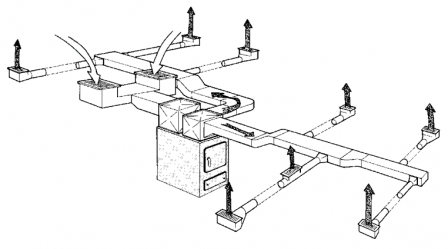 Mechanics of a forced-air furnace
Mechanics of a forced-air furnace
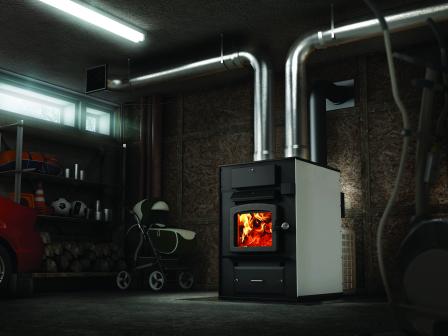 Forced air furnace
Forced air furnace
What is a hydronic heater/outdoor wood boiler?
Hydronic heaters (also called outdoor wood heaters or outdoor wood boilers) are generally located outside the buildings they heat in small sheds with short smokestacks. Typically, they burn wood to heat liquid (water or water-antifreeze) that is piped to provide heat and hot water to occupied buildings such as homes, barns and greenhouses. However, hydronic heaters may also be located indoors and they may use other biomass as fuel (such as corn or wood pellets).
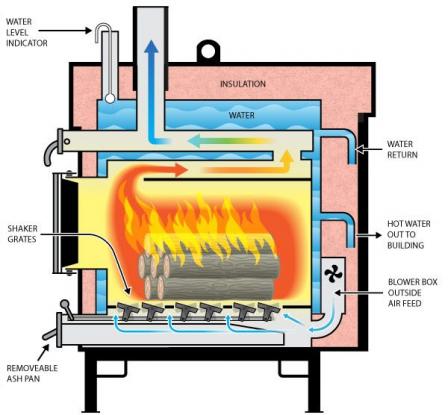 Hydronic heater cross-section
Hydronic heater cross-section
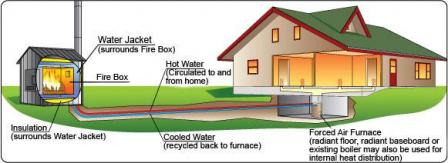 How a hydronic heater warms a house
How a hydronic heater warms a house
What is the best stove for me – type, size, cost?
It really depends on your needs, preferences, and budget. You can find stoves in a number of sizes, styles, and prices to suit your checkbook. If you choose to burn wood, there are a variety of EPA-certified wood stoves to choose from. If you prefer not to haul or chop wood, a pellet or gas stove may be more convenient. If heat during a power outage is a concern, you should know that the automatic pellet feed system in pellet stoves requires electric power.
How do fireplaces compare to wood stoves? Are they as efficient?
Generally, fireplaces are not an efficient means of burning wood. They do not burn as cleanly as an EPA-certified wood stove. Furthermore, fireplaces provide less heat to your home, since most of the heat from a fireplace goes out the chimney. Most fireplace owners do not use their fireplaces as a primary source of heat. They may burn wood in their fireplace as supplemental heat on chilly days, or to provide ambiance to their home. For more efficient heating with less smoke, consider having a gas, pellet, or EPA-certified wood fireplace insert installed in your fireplace.
What is the difference between a masonry heater and a masonry fireplace?
While masonry heaters and masonry fireplaces both provide warmth and ambience in a home, they differ significantly in design. Both devices may be built from brick, block, or stone, and employ a firebox. But a masonry heater differs from a masonry fireplace in that it features a large masonry mass, and a maze of heat exchange channels. These features allow a masonry heater to store heat from a fire within its masonry structure. After the fire burns out, the masonry heater continues to release heat into the home throughout the day. A masonry fireplace only provides warmth while the fire is burning.
Because masonry heaters are designed to burn small, rapid, hot fires, they produce far less smoke than a masonry fireplace, low-mass fireplace, or non-certified wood stove - yet the heater's surface does not become too warm to touch.
What are fireplace inserts?
A fireplace insert is a wood stove designed to fit inside an existing fireplace. It functions just as a wood stove does and should be EPA-certified. And just as there are gas and pellet stoves, there are gas and pellet fireplace inserts that burn cleaner and more efficiently.
What are firelogs?
The term "firelog" or "fire log" can refer to two things. It can mean an artificial log containing gas burners – also known as a "gas log" – designed to give the appearance of a real wood log in a gas fireplace or stove. It can also refer to a log manufactured from compressed sawdust and/or other organic material, sometimes blended with wax, for burning in a fireplace. Gas logs are generally not an air pollution issue; firelogs manufactured for burning may be of concern.
Are manufactured fire logs okay to burn in fireplaces? What about wood stoves and fireplace inserts?
Data show that burning one manufactured wood log in a fireplace emitted less air pollution than burning several pieces of wood. If you burn a manufactured log, you should be sure to follow the manufacturer's instructions, only burn one log at a time, not only to reduce air pollution, but also for fire safety. If you use manufactured logs, choose those made from 100 percent compressed sawdust. Burning in a fireplace, whether you burn manufactured logs or real wood logs, is not an efficient way to heat your home. You should not burn logs made from wax and sawdust in your wood stove or fireplace insert – they are made for open hearth fireplaces.
What are ethanol fireplaces and how are they different from wood burning fireplaces?
Decorative ethanol fireplaces are becoming increasingly popular globally. They differ from traditional fireplaces in that they do not burn wood but rather use low-cost alcohols such as ethanol and 2-propanol for fuel. They are not generally used for heating and are mainly decorative. For safety reasons, ethanol is often used in gel-form or as a paste (e.g., by adding calcium acetate), so that serious fires cannot occur from spilling liquid across the floor. If liquid fuels are used, an accident can mean severe injuries. These fireplaces are typically not vented to the outside either, meaning that all of the products from combustion, including volatile organic compounds (VOCs) and other gases and particulate matter are released into the interior of the building. In 2013, a German study (Environ. Sci.Technol., 2014, 48 (6), pp 3583–3590 DOI: 10.1021/es404972s) showed that the quantity of carbon dioxide and nitrogen dioxide emitted by these devices were high. The ethanol fireplaces were also strong sources of fine particles and can emit hazardous air pollutants such as benzene and formaldehyde. The study concludes that ethanol fireplaces’ adverse impact on indoor air quality and fire safety should be considered when using such devices.
About EPA-Certified Stoves
How are EPA-certified stoves different, and why are they better?
“Certified” means that a wood-burning appliance meets EPA clean air standards. It generates less smoke (fewer particles) than a non-certified stove and uses less wood to create more heat. Only new stoves are certified. Certification takes place when the stove is manufactured.
EPA-certified appliances include:
- Wood and pellet stoves
- Fireplace inserts
- Hydronic heaters (outdoor wood boilers)
- Forced air furnaces
Fireplaces and masonry heaters are not certified by EPA.
All certified wood-burning appliances have been independently tested by an accredited laboratory to meet particulate emission limits specific to the type of appliance.
Where can I purchase an EPA-certified stove?
Most of the wood-burning stoves on the market today are EPA-certified stoves, so you should be able to buy one from any retailer of hearth products. The Hearth, Patio, and Barbecue Association Exit can help you find a retailer near you. It's important not only to purchase an EPA-certified stove, but also to have it properly installed by a certified technician.
Is "EPA-certified" the same as "EPA-qualified"?
No, Since 1988, the EPA has implemented the regulations called the Residential Wood Heater New Source Performance Standards (NSPS) that govern the manufacture and sale of wood heaters (wood and pellet stoves, fireplace inserts, hydronic heaters and force-air furnaces). Models that meet the requirements of the NSPS are considered EPA-certified. EPA-qualified is a term used for fireplaces that have been demonstrated to meet the emission levels set by EPA's Voluntary Fireplace Program. These fireplaces can emit no more than 5.1 grams of particulate matter per kilogram of wood burned in order to qualify for the voluntary program. EPA started this program to encourage manufacturers to make lower emitting models because fireplaces are not considered wood heaters and therefore not covered under the NSPS but do emit harmful air pollution.
How can I tell if my stove is EPA-certified?
EPA-certified wood stoves will be labeled on the back, indicating EPA certification. If you're shopping for a new stove, in addition to the label, the stove will have a white hang tag indicating it is EPA-certified. You can also check EPA's certified wood heater database.
Can I get my stove certified?
No. Certification is completed by stove manufacturers when introducing a new model line. To meet certification requirements, stoves must have pollution control systems built into them.
Will switching to an EPA-certified stove really save me money?
Yes. With an EPA-certified wood stove, you can expect to use up to one-third less firewood than you would using an older, less efficient stove. The smoke that you see coming out of the chimney is really lost energy. In an EPA-certified stove, most of the smoke is burned, resulting in more heat for your home from the same amount of wood. It will also save you time because you will need to haul less wood.
As for the best stove size, talk with experienced hearth product retailers who know the performance characteristics of the products they sell. Bring a floor plan of your home when you visit them. Knowledgeable retailers can help you find a wood stove, fireplace insert, or other hearth product that is well suited to the space you want to heat. You can find local retailers through the Hearth, Patio, and Barbecue Association.Exit
What makes an EPA-certified wood stove burn cleaner than a non-certified wood stove?
When wood is not completely burned, a complex mixture of gases and particles – wood smoke – is created. Because EPA-certified wood stoves are designed with better insulation and improved air flow, more of these gases and particles are burned inside the stove, resulting in less smoke. In most cases, you will see no visible emissions from the chimney, and you will smell less smoke from a properly installed EPA-certified stove.
Stove Installation and Replacement
How can I find out about wood stove changeout programs in my area?
Contact your state, tribal or local air pollution agency.
Can EPA give me a rebate/discount to replace my wood stove for a wood, pellet, or gas stove?
Unfortunately, the EPA does not provide individual rebates or discounts for cleaner-burning stoves. Check with your state, tribal, or local air pollution agency and your local hearth products retailer to see if they are offering any discounts on cleaner burning stoves.
The local air pollution agency says I can't sell my old wood stove to help pay for an EPA-certified wood stove. Why is that?
Replacing an older stove with a cleaner-burning stove will not improve air quality if the older stove is reused somewhere else. For this reason, wood stove changeout programs usually require older stoves to be destroyed and recycled as scrap metal, or rendered inoperable.
How much will replacing my stove with a cleaner-burning stove cost?
The cost of a cleaner burning stove varies depending on the size, style, and features of the stove you choose. Generally, you can find prices ranging from around $750 to $3500. The cost of installation can also vary depending on the condition of the existing chimney (e.g., you may need a new chimney flue), ranging from $600 to $1200.
I've been told I can't get a rebate for a cleaner-burning wood stove if I install the stove myself. Why can't I install my own stove and save the installation expense?
EPA strongly recommends that a certified technician install your EPA-certified wood stove or fireplace insert to insure proper performance. First, the safety of your home and family depends on a full understanding of the manufacturer and building code requirements. Any errors in installation (by a non-professional) may not be visible, and problems may not be apparent for a considerable length of time — and some could result in a home fire.
Second, proper functioning of the venting system (a.k.a. the chimney) is the key to efficient, cleaner wood-burning. The venting system is the "engine" that drives the burning process; if it does not provide adequate draft, your stove will perform poorly or fail. A stove and venting system that is properly sized and installed will require less wood, produce more usable heat, and reduce maintenance from inefficient fires.
What can I do with my non-certified stove when I want to get rid of it?
Used, non-certified stoves can often be sold for scrap or sometimes traded in on the purchase of a certified stove, or non-wood-burning heater, (i.e. natural gas, stove or fireplace). Check with local wood stove retailers for trade-in options. To help keep your air cleaner, make sure your old wood stove can not be used to burn wood (for example, remove the doors from the old stove).
Do I need a permit to install a wood stove?
It depends where you live. Check with your local city or county building department for details on permit requirements in your area.
Pollution and Safety Issues
What is emitted when wood burns?
Smoke forms when wood or other organic matter burns. The emissions vary, depending on the intensity of the fire and whether it burns in the open or in a woodstove or other wood heater.
When wood isn’t burned completely, the smoke it produces contains fine particles (also called particle pollution, particulate matter, or PM2.5), along with carbon monoxide and toxic air pollutants including benzene, formaldehyde, acrolein, and polycyclic aromatic hydrocarbons, and others. The more efficiently wood burns (e.g., using an EPA-certified wood stove and dry, seasoned wood), the less smoke is created.
What happens when you inhale wood smoke?
The biggest health threat from smoke comes from fine particles-- also called fine particulate matter or PM2.5. These microscopic particles can get into your eyes and respiratory system, where they can cause burning eyes, runny nose, and illnesses, such as bronchitis. Fine particles can make asthma symptoms worse and trigger asthma attacks. They can also trigger heart attacks, stroke, irregular heart rhythms, and heart failure, especially in people who are already at risk for these conditions.
Wood smoke can affect everyone, but children under 18, older adults, people with heart disease, people with asthma or other lung diseases, and people with diabetes are the most vulnerable.
I can smell smoke in my home when I burn wood. Should I be concerned?
If you smell smoke in your home, something may be wrong. You should have your wood-burning appliance checked by a certified chimney sweep or similar certified professional. For a certified professional near you, consult the Chimney Safety Institute of America (CSIA)Exit or the National Fireplace Institute (NFI).Exit
What is creosote, and why is it bad?
When smoke, i.e. combustion by-products, created by burning wood rise into the cooler chimney they can condense and stick to the inside walls of the chimney. This is called creosote, which is highly combustible black or brown residue. If enough builds up, it could cause a chimney fire.
Creosote tends to build up under the following conditions:
- Restricted air supply: when the appliance doors are closed, if the damper isn’t open wide enough, or if air flow is not sufficient to move heated smoke quickly up the chimney. The longer smoke stays in the flue, the more likely that creosote will form.
- Burning unseasoned wood: a lot of energy is necessary to get the water out of unseasoned logs before they can burn. This produces more smoke, which deposits more creosote as it moves through the chimney.
- Your chimney is cooler than normal: if the outside air temperature is very cold, condensation can occur more readily.
- Overloading the firebox in wood stoves to get a longer burn time. This can also damage the firebox and create a safety risk.
Remember, clean chimneys don’t catch fire!
People have been burning wood since the Stone age – why is wood smoke a problem now?
Indeed, wood smoke has been around since the discovery of fire; it is something we all are familiar with. Over time, we have learned a great deal about wood smoke and its health effects. Wood smoke is a complex mixture of gases and particles. When these microscopic particles get into your eyes and respiratory system, they can cause health problems such as burning eyes, runny nose, and illnesses such as bronchitis. Particle pollution also can aggravate chronic heart and lung diseases—and is linked to premature death in people with these chronic conditions.
Are new stoves safer? Do they have less creosote buildup?
Creosote is a combustible residue formed by wood gases that are not completely burned. If too much creosote builds up in a chimney, it can lead to a chimney fire. EPA-certified wood stoves burn more efficiently than older non-certified models, resulting in less creosote buildup in the chimney. So replacing an old, non-certified stove with an EPA-certified stove will reduce the chances of a chimney fire. Nonetheless, EPA and fire officials recommend having your wood stove, chimney, and vents professionally inspected and cleaned each year to keep them in safe working order. The Chimney Safety Institute of America (CSIA)Exit provides a list of certified chimney sweeps, searchable by state.
In addition to residential wood heaters, what are other sources of wood smoke?
Forest fires are the largest source of wood smoke emissions. Other residential sources include outdoor fire pits, chimeneas, and backyard burn barrels. Industrial, commercial, and institutional boilers and cook stoves that use wood as fuel are also sources of wood smoke.
What are the more efficient, cleaner ways to heat homes?
Efficient and clean ways to heat a home include passive solar heat, active solar, geothermal heat pumps (GHPs), and natural gas. If you do heat your home with wood, do so as cleanly as possible. Use an EPA-certified heating appliance and only burn dry, seasoned wood to reduce the amount of particle pollution your wood heater produces.
Is it true that wood smoke often contributes more harmful particulates than any other source in urban areas?
Residential wood smoke can be a significant source of particle pollution emissions in some communities. For example, in King County, Wash. (the Seattle area), residential wood smoke was the largest single source category of direct particle pollution emissions, contributing nearly a third of all annual direct PM2.5 emissions, according to EPA’s 2014 National Emissions Inventory, v.1.
What are no-burn days?
No-burn days are also called burn bans or curtailment programs. They are voluntary or mandatory measures used by state and local government agencies to stop air quality from reaching unhealthy levels, or to prevent further degradation of air quality. On no-burn days, backyard and opening burning are often prohibited, and some areas limit the use of wood burning stoves and fireplaces. Exact requirements vary by area. Programs generally provide a waiver mechanism for people who burn wood as their sole source of heat.

